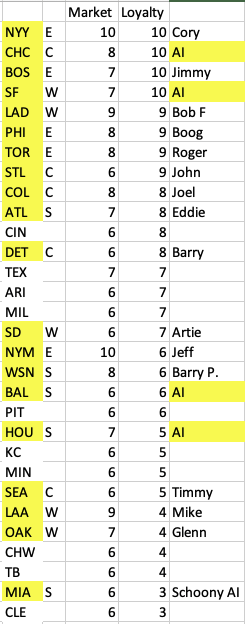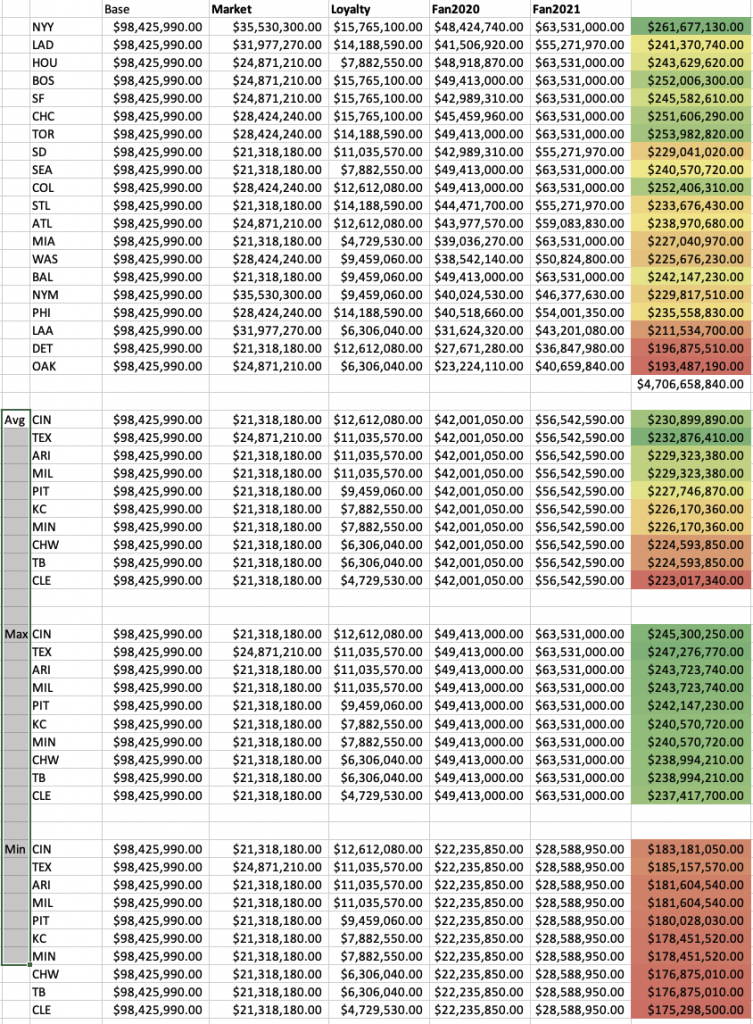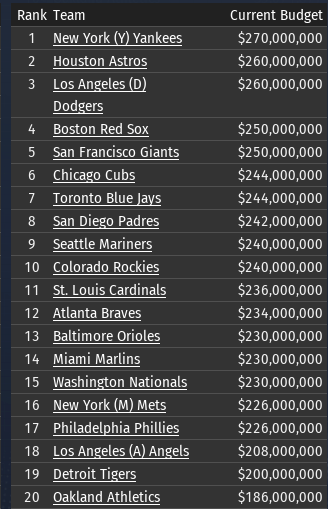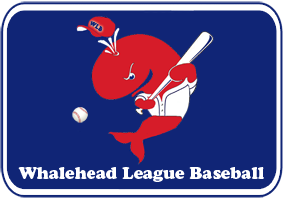
The WLB Economics set up was changed for the 2024 WLB season. What follows is a description of the previous setup.
As long-time league members know, our league has always had an economic component. Initially, way back in 1990, our economic system was modeled on Rotisserie Baseball. Over time our economic system became more realistic (and complicated). Eventually, it pretty closely mimicked MLB, with one major difference, the range between the top and bottom teams was compressed to 60%.
When we moved to OOTP, it’s was a fairly simple process to integrate our finances with OOTP’s way of doing things. What helped the process was the extensive research and testing I undertook to make the transition pretty seamless. First, I worked to set realistic markets (detached from the way OOTP does it). Next, I looked into real-life fan loyalty research. From there I established base market sizes and fan loyalty settings. I then ran a large number of OOTP season simulations for data to generate a workable model of its franchises.
Here are the settings that I came up with for each market.

My research suggests that I can fairly reflect OOTP’s economic model (a 90% correlation). Our three-year game experience supports my original research.
With that in mind, I estimated the changes in revenue for each market. The relevant numbers are the colored dollar figures in the last column. The top markets are our current markets. The bottom available markets are broken down with Fan Interest of Avg (89 in our league), Max (100), and Min (45). These are estimates of how much revenue/budgets will change by moving to a different market in the 2021 season. (The actual spreadsheet adjusts the estimates based on league-wide revenue.)

All teams equalized to Average Fan Interest.

Other Considerations
Fan Interest
If you look at the numbers above closely, you’ll notice that Fan Interest has a very large direct impact on revenue/budgets. With that in mind, it’s important that we factor in changes to Fan Interest when a team decides to leave a market and move to another market.
In OOTP there is a viewable Fan Interest rating. This rating is based on a hidden base Fan Interest rating and a hidden Fan Interest Modifier. The hidden base is slower to change. The hidden Fan Interest Modifier fluctuates and changes more quickly. It gets added to hidden Fan Interest and impacts the viewable Fan Interest. Factors that impact the Modifier include stuff like signing or losing a popular player.
When expansion takes place in OOTP the Modifier gets set at 100. With that in mind, I’m incorporating a factor for franchise moves. I’ll use 75 as a base change to the Modifier. The time a team announces when its move will determine what percentage of the modifier will be added/subtracted. If the move is announced before the season begins 75 will be subtracted from its modifier for its last year in the market. The following season 75 will be added to its modifier. Otherwise, games played / 162 will dictate the percentage.
For example: in 2021 Oakland announced a move after its 49th game. 49/162 = 30%. Oakland’s Modifier will be reduced by 53 points ((1-.3)*75) in 2021. In 2022 when the move becomes official, it will be increased by 53 points. (Seattle will be reduced by 54 points after playing 45 games. San Francisco will be reduced by 38 points.)
Team Budgets
Our team Budgets are based on the previous year’s Revenues. Teams that move will have their initial Budgets determined by their end-of-season revenues. (This is based on the assumption that revenues will drop after the Fan Interest Modifier is adjusted. If the Commissioner finds this does not operate as expected, the calculation may be changed.)
Our 2021 team Budgets.


Be the first to comment